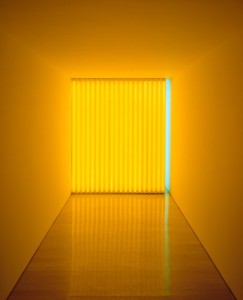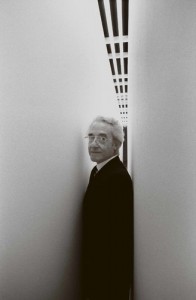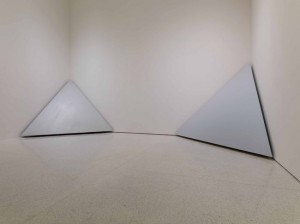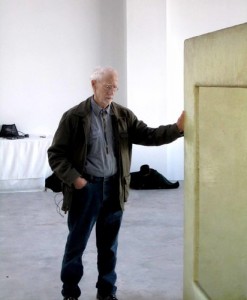Tricky Business: Defining Authenticity
When the Guggenheim Museum sold pieces by Kandinsky, Chagall and Modigliani in the early 1990s to help it buy one of the world’s most important collections of Minimalist and Conceptual art, it knew it was paying not only for hundreds of seminal works but also for a mare’s nest of problems.

An authorized installation of Dan Flavin's "Untitled (To Jan and Ron Greenberg)," in the Guggenheim Museum's Panza Collection. Nytcredit: Sally Ritts/Solomon R. Guggenheim Foundation
And many of those problems went straight to the heart of the kinds of questions asked by the challenging work itself, made in the 1960s and ’70s by pioneers like Donald Judd, Dan Flavin and Robert Morris. What was the meaning of authenticity in art? Did artists have to make art themselves? Could copies by the artists or others be as “authentic” as originals?
Could an artist — as Mr. Morris did when angered by the architect Philip Johnson’s delinquency in paying for a sculpture — simply write that he was taking back “all aesthetic quality” from the work, rendering it a worthless hunk of metal and wood? (Both the Morris sculpture and the conceptual dunning letter now reside in the collection of the Museum of Modern Art, showing how history sometimes sorts through such questions by itself.)
The issues confronted by the Guggenheim were aesthetic and philosophical but also legal and starkly practical: Would the museum ever be able to show some of these pieces bought from Count Giuseppe Panza di Biumo, a visionary Italian collector of postwar art? Or did Panza, who sometimes saw himself as an artistic collaborator and who fabricated some works from artists’ plans, go too far in substituting his own ideas for those of the exacting artists he collected, creating illegitimate art? Could some works — deemed legitimate but too damaged through time ever to show — be remade by the museum or the artists and replace the older ones?
“The work poses deep philosophical and aesthetic issues that will not soon be resolved,” Michael Govan, then a deputy Guggenheim director, said in 1990. “We won’t do it all in four weeks.”
It has taken, indeed, more than two decades. But since 2010 the Guggenheim has been quietly engaged in one of the most ambitious conservation projects ever to address the deep uncertainties raised by Minimalism and Conceptualism, which brought highly unconventional materials — plywood, hardware, industrial metals — and even more unconventional ideas to art, questioning the importance of objects and of the artist’s hand. Some answers the project is now reaching will be surprising: that, for example, the most responsible act of conservation might be the destruction of a piece of art because, in the final analysis, it is not really a piece of art.
The project’s stakes have been evident in its financing alone: two grants totaling almost $2.5 million from the Andrew W. Mellon Foundation for an initiative that will continue for more than another year. And its conclusions — being reached after meetings of more than a hundred fellow conservators, curators, scholars, lawyers, and some of the living artists — will undoubtedly reverberate far beyond the Guggenheim’s walls, to other museums, and to galleries and auction houses.

Count Giuseppe Panza di Biumo, one of the most important collectors of post-war American art, standing inside Bruce Nauman's "Green Light Corridor." All rights reserved, Giorgio Colombo, Milan
“These questions are being asked by everybody now, by every collector and museum that has work from this pivotal generation,” said Jeffrey Weiss, the Guggenheim’s senior curator in charge of the Panza Collection. “But decisions tend to be made individually. We don’t talk to each other about these things nearly enough. And the terms set out by this work are a frontier only now being explored.”
Over the last year and a half, the museum invited a reporter to observe, as long unseen pieces by Mr. Morris, Bruce Nauman, Lawrence Weiner, Judd (who died in 1994) and Flavin (who died in 1996) were taken from storage and debated — sometimes, in a sense, as defendants on trial for their lives — in spaces at the Brooklyn Navy Yard and at the Guggenheim. In private, Mr. Weiss and Francesca Esmay, the museum’s conservator for the Panza Collection, spent dozens of hours interviewing Mr. Weiner, whose works exist mostly as words painted on walls, and Mr. Morris, a highly private artist who has argued that there are no originals to his works, only ideas that can be refabricated as needed.
Always, in the background, were the words left behind by the artists no longer around to defend their work. In particular there were the words of Judd, who broke angrily and publicly with Panza at the time of the sale to the Guggenheim, in a long essay in which he accused the collector of making his signature boxlike works from Judd’s plans but without his approval, incorrectly and with inferior materials. “Panza doesn’t care,” he wrote. “What I require is too expensive. Consequently, Panza makes mock-ups, fakes.”
Judd was among a wave of postwar artists to introduce the idea of industrial fabrication — the removal of the artist’s hand — to the conception of art. And most of his best-known geometric objects, in plywood, metal and other materials, were made by specialty craftsmen. But this hands-off delegation, far from distancing him from the work, seemed only to deepen his control, one of many facts that Panza, who died in 2010, failed to grasp, Judd said. (Many artists also complained that Panza underpaid for their work.)
“His understanding of my work was simply shady,” Judd wrote, “either genuinely and superficially wrong or conveniently wrong, since his misunderstanding allowed him to build as he pleased.” One recent afternoon in a private gallery at the Guggenheim, Mr. Weiss, Ms. Esmay and Ted Mann, an assistant curator working on the project, examined several examples of Judd works made by Panza and not seen by the public since the collection came to the museum. While the boxlike works closely resembled Judd pieces, the differences — in the look of the plywood, the way the panels were assembled, even in the screws used — made some appear more like nonfunctional furniture than like the highly specific work Judd made.

Two versions of Robert Morris's "Untitled (Corner Piece)": a 1967 Morris fabrication, left, and the Guggenheim's new painted plywood one. Nytcredit: Kristopher Mckay/Solomon R. Guggenheim Foundation
“If he were alive today to see this,” Ms. Esmay said, looking at one work.
“He would die,” Mr. Weiss said.
Ms. Esmay added, “These stand not only as an incredible demonstration of what not to do but a demonstration of the quality of Judd’s authentic work.”
While the fate of the Panza works has not been fully decided, there is now little likelihood that they will ever be shown at the Guggenheim. “It’s very, very difficult to argue,” Mr. Weiss said later, “that works that an artist disavowed can ever be successfully fought for.” Even the question of whether the works will be kept for their historical value is fraught; many Judd partisans would like to see them destroyed because of fears they might be shown as legitimate at some point.
But Mr. Weiss said they might be saved. “They were shown by Panza, and they were taken to be Judds by a lot of people over many years,” he said. “So I think they have a historical role of some sort in the transmission of Judd’s works.”
The number of contested works by Judd and others in the collection represents a small fraction of the whole, and by any measure — art historical, curatorial, financial — the acquisition, which cost the museum more than $30 million, now stands as a remarkably prescient decision by the Guggenheim. (On the market today, the works would cost the museum many times what it paid then.) But the problems have continued to loom large, in part because they force the museum and others around the world to come to terms with work that questions ideas underpinning the very existence of museums themselves.
“It’s tough,” said Virginia Rutledge, an art lawyer who advised the project. “It is about the very human desire to value something created by someone at a certain point in history but also to honor what that person wants or wanted.”
The conflicts between objects and artists that the Panza Collection provoked were very raw in the early days, said Mr. Govan, now the director of the Los Angeles County Museum of Art: “That’s how I got to know a lot of those artists — under duress, because they were all mad.”
“But as time goes on, that’s no longer going to be the story,” he said and added that Panza’s role as promoter and protector of the work of a crucial era should not be overshadowed by the problems. “It’s hard for us to imagine now how radical this work was, and he was light years ahead.”

Robert Morris with his "Untitled (Fiberglass Frame)," part of the Guggenheim's Panza collection. Michelle Donnelly/Solomon R. Guggenheim Foundation
For all the drama surrounding the Judd questions, those regarding Mr. Morris, 82, plunge far deeper into the murky territory of their time. One of Mr. Morris’s signature works, “Untitled (Corner Piece)” from 1964, a flat-gray triangular mass that seems to float snug in a corner, was shown in a show at Richard Bellamy’s Green Gallery on West 57th Street in Manhattan. The piece, made of plywood, was subsequently thrown away, a fate met by many Morris works from those days, because he believed the objects could — and should — be remade and were secondary to the ideas they embodied. The piece was later remade by Mr. Morris in gray fiberglass and sold to Panza. But it came to the Guggenheim badly damaged, with cracks, screw holes and discolorations.
The piece — which Mr. Weiss called “a complicated little sucker” — also came loaded with questions of what it was, exactly. An exhibition copy? A historical refabrication? In long, philosophical, often contradictory discussions with Mr. Morris, the questions were: Should the piece be remade? And if so, how? The Robert Morris of the 1960s most likely would have absented himself from any such debate about objects and materials. But Mr. Morris’s view about the physical importance of his works had changed over the years, and he came to favor remaking the corner piece in the original plywood, which the Guggenheim’s fabrication shop has done.
And so the next time the work is seen in an exhibition, it will be the 2013 iteration of a 1964 piece, with — or maybe without — a label telling viewers that it has been remade. The older work will probably be kept for study purposes, but several Morris pieces made by Panza without the artist’s involvement will most likely be destroyed and refabricated.
“People are always asking us, ‘What does the artist want?’ — as if that’s a simple, monolithic thing,” Mr. Weiss said. “It turns out that it’s one of the most complicated parts of the whole process. It’s not just him and us. It’s the changing him and the informed us.”
“And no matter how we try to deny it,” he added, “the tug of history is always very strong.”
By Randy Kennedy
Source: http://www.nytimes.com